|
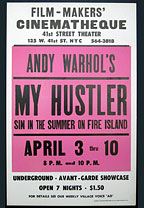
My Hustler
1965
Director:
Andy Warhol
Screenplay:
Chuck Wein
Starring;
Paul America,
Joseph Campbell,
Ed Hood,
Genevieve Charbon,
Dorothy Dean,
J.D. McDermott
Unrated,
67 minutes |
Warhol On The Beach
by
Michael D. Klemm
Posted online June, 2014
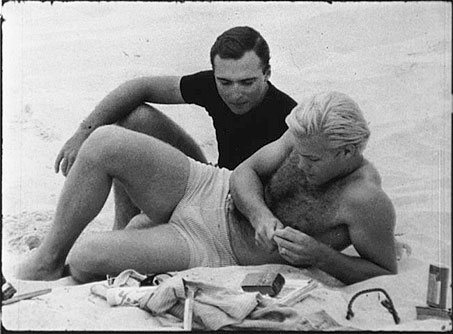
Ah… the underground films of Andy Warhol. The films have more than their share of admirers and detractors (though mostly the latter) and it’s easy to be flip about them. In the prologue to The Picture Of Dorian Gray, Oscar Wilde famously wrote that once a “beautiful thing” becomes a useful object it ceases to be a work of art. Andy Warhol took the opposing view; banal everyday objects (i.e. Campbell’s soup cans) could be works of art. For good or bad, his Pop Art aesthetic was extended to his early Factory films. |
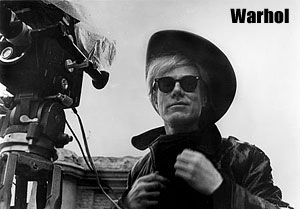 Warhol didn’t believe in mundane things like scripts or plots. He was capturing what he felt was a more heightened reality. But there’s no beating around the bush about this; his films are amateurish, badly acted (many performers were stoned) and often incoherent. Yet they are not without historical interest, and many of them had a decidedly queer bent. Warhol was, himself, gay and many of his “superstars” were gay, lesbian, and transgender (not to mention drag queens). One movie that might still intrigue gay audiences today - or at least students of queer cinema - is 1965’s My Hustler. Not because it is a particularly good movie (although it is Citizen Kane compared to his eight hour film of the Empire State Building) but because the queer subject was uncommon and, in fact, rather groundbreaking for its time. Warhol didn’t believe in mundane things like scripts or plots. He was capturing what he felt was a more heightened reality. But there’s no beating around the bush about this; his films are amateurish, badly acted (many performers were stoned) and often incoherent. Yet they are not without historical interest, and many of them had a decidedly queer bent. Warhol was, himself, gay and many of his “superstars” were gay, lesbian, and transgender (not to mention drag queens). One movie that might still intrigue gay audiences today - or at least students of queer cinema - is 1965’s My Hustler. Not because it is a particularly good movie (although it is Citizen Kane compared to his eight hour film of the Empire State Building) but because the queer subject was uncommon and, in fact, rather groundbreaking for its time.
|
|
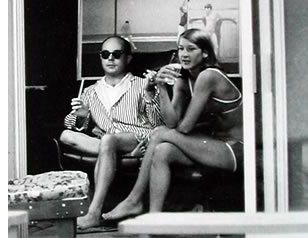 The 67 minute film is shot in two long camera takes (each ends when the film runs out). The plot is simple. The setting is a beach house at Fire Island. A bitchy, middle-aged queen (Ed Hood) and his next door neighbor (Genevieve Charbon) are ogling a gorgeous, muscular man who is sunning himself on the beach. Ed announces that he ordered the young hunk (Paul America) from Dial-A-Hustler to spend the weekend with him. They are joined by an older hustler (Joseph Campbell) whom Ed recognizes as “the Sugar Plum Fairy” - a euphemism for drug dealer. All three of them want Paul for themselves, and their conversations reduce him to a piece of meat. The movie’s second half is one static shot filmed inside a cramped bathroom. The viewer is teased for 33 minutes as the two hustlers pose, preen and groom themselves and each other. It functions, in some ways, as a claustrophobic peep show. The 67 minute film is shot in two long camera takes (each ends when the film runs out). The plot is simple. The setting is a beach house at Fire Island. A bitchy, middle-aged queen (Ed Hood) and his next door neighbor (Genevieve Charbon) are ogling a gorgeous, muscular man who is sunning himself on the beach. Ed announces that he ordered the young hunk (Paul America) from Dial-A-Hustler to spend the weekend with him. They are joined by an older hustler (Joseph Campbell) whom Ed recognizes as “the Sugar Plum Fairy” - a euphemism for drug dealer. All three of them want Paul for themselves, and their conversations reduce him to a piece of meat. The movie’s second half is one static shot filmed inside a cramped bathroom. The viewer is teased for 33 minutes as the two hustlers pose, preen and groom themselves and each other. It functions, in some ways, as a claustrophobic peep show.
|
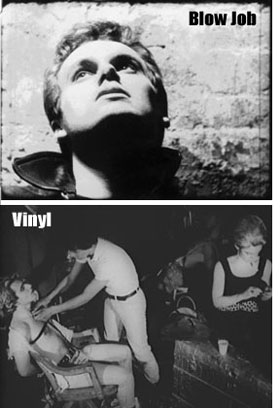 Before going any further, I’d like to point out that the first reel’s panoramic beach photography (with its numerous swish pans between the house and the beach, zooms and two in-camera strobe edits) was a dramatic departure for Warhol. Most of his previous films had been shot at The Factory, his warehouse art studio. His numerous “Screen Tests” were extended exercises in portraiture. 1963’s Sleep is a five and a half hour film about poet John Giorno sleeping. Blowjob (1964) is a 41 minute close-up of a man who is supposedly being fellated off camera. A truly subversive moment (for 1963) occurs in Kiss when the camera pulls back to reveal that one of the kissing couples is actually two MEN. Vinyl (1965) is a very loose adaptation of A Clockwork Orange with lots of S&M bondage. It features Warhol regulars Gerard Malanga in a leather jacket, dancing, and Edie Sedgwick getting drunk on the side of the screen. My Hustler, for all its clumsiness, actually almost resembles a conventional narrative film. Paul Morrissey, who directed the later commercial Warhol films with Joe Dallesandro, claims co-authorship of My Hustler, but several of his contemporaries dispute this. Before going any further, I’d like to point out that the first reel’s panoramic beach photography (with its numerous swish pans between the house and the beach, zooms and two in-camera strobe edits) was a dramatic departure for Warhol. Most of his previous films had been shot at The Factory, his warehouse art studio. His numerous “Screen Tests” were extended exercises in portraiture. 1963’s Sleep is a five and a half hour film about poet John Giorno sleeping. Blowjob (1964) is a 41 minute close-up of a man who is supposedly being fellated off camera. A truly subversive moment (for 1963) occurs in Kiss when the camera pulls back to reveal that one of the kissing couples is actually two MEN. Vinyl (1965) is a very loose adaptation of A Clockwork Orange with lots of S&M bondage. It features Warhol regulars Gerard Malanga in a leather jacket, dancing, and Edie Sedgwick getting drunk on the side of the screen. My Hustler, for all its clumsiness, actually almost resembles a conventional narrative film. Paul Morrissey, who directed the later commercial Warhol films with Joe Dallesandro, claims co-authorship of My Hustler, but several of his contemporaries dispute this.
|
 Reportedly, most of My Hustler was improvised. It shows. Still, improvisation on this scale isn’t easy to pull off (even with talented actors) and so the results are predictably mixed. Some of the dialogue is delightfully naughty and some of it is sophomoric. “What does he remind you of?” Ed asks Genevieve. “The Leaning Tower of Pisa? Or the Empire State Building? Or a big fat sausage?” Periodically, the camera swings from the lascivious neighbors to the beach where Paul lays on his side in the sand, the crotch of his swimsuit directly facing the viewer and not leaving much to the imagination. Like the voyeurs in the film, we are also invited to admire the hustler’s body. This is a good thing because it gives us a reason to sit through some of the more inane voice-overs. (“Maybe you’d like to run in your high heels through all the hair on his chest.”) Genevieve goes down to the beach where she and Paul rub suntan lotion on each other’s backs. Ed tells Joe, the older hustler, that she’s “a fag hag, all she does is steal tricks.” Joe reveals that he has been with Paul before, and that he came here to meet him, and the two men begin to bicker. While they discuss the size of Paul’s penis, the hustler frolics with the fag hag in the surf and the film runs out. Reportedly, most of My Hustler was improvised. It shows. Still, improvisation on this scale isn’t easy to pull off (even with talented actors) and so the results are predictably mixed. Some of the dialogue is delightfully naughty and some of it is sophomoric. “What does he remind you of?” Ed asks Genevieve. “The Leaning Tower of Pisa? Or the Empire State Building? Or a big fat sausage?” Periodically, the camera swings from the lascivious neighbors to the beach where Paul lays on his side in the sand, the crotch of his swimsuit directly facing the viewer and not leaving much to the imagination. Like the voyeurs in the film, we are also invited to admire the hustler’s body. This is a good thing because it gives us a reason to sit through some of the more inane voice-overs. (“Maybe you’d like to run in your high heels through all the hair on his chest.”) Genevieve goes down to the beach where she and Paul rub suntan lotion on each other’s backs. Ed tells Joe, the older hustler, that she’s “a fag hag, all she does is steal tricks.” Joe reveals that he has been with Paul before, and that he came here to meet him, and the two men begin to bicker. While they discuss the size of Paul’s penis, the hustler frolics with the fag hag in the surf and the film runs out.
|
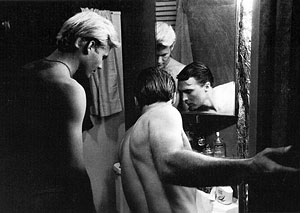 The rest of the movie takes place in a tiny bathroom; the camera sits just outside of the door and doesn’t move. Joe admires Paul’s body and the younger hustler drinks it all in while pretending to be aloof. Again, like in the first reel, it’s all about gazing – both ours and the camera’s. Both men wear only a towel, and sometimes nothing at all. (Joe goes the full monty.) They take turns preening like peacocks in front of the medicine cabinet mirror. Like the audience, they also are unable to stop gazing at themselves. Each showers and, at one point, Paul takes a piss. They shave, comb their hair, brush teeth, apply ointments, cologne and deodorant, clean their ears with Q-Tips and file their nails. At least one of them is reflected in the mirror most of the time. The rest of the movie takes place in a tiny bathroom; the camera sits just outside of the door and doesn’t move. Joe admires Paul’s body and the younger hustler drinks it all in while pretending to be aloof. Again, like in the first reel, it’s all about gazing – both ours and the camera’s. Both men wear only a towel, and sometimes nothing at all. (Joe goes the full monty.) They take turns preening like peacocks in front of the medicine cabinet mirror. Like the audience, they also are unable to stop gazing at themselves. Each showers and, at one point, Paul takes a piss. They shave, comb their hair, brush teeth, apply ointments, cologne and deodorant, clean their ears with Q-Tips and file their nails. At least one of them is reflected in the mirror most of the time.
|
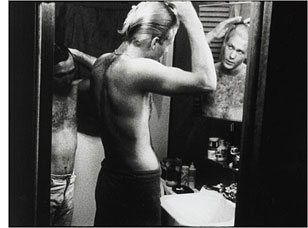 Throughout all this, the men talk almost non-stop. Paul needs a job and the older hustler offers to take Paul under his wing, show him the ropes, and pimp him to his wealthier clients. He will want something, of course, in return. Paul is either slow or just acts naïve, claiming that his host, Ed, only wants to have dinner with him over the weekend. Joe tells Paul that he can be much more than just a “dinner john” and asks him if he’d like to make more money. He’s done it for 18 years but insists that he’s not a 42nd Street hustler. Paul says, “Oh, I know you’re not a hustler, but you’ve been around. How much can a guy make?” Joe tells Paul that he has a good body, and discusses what some clients like to do – sometimes in graphic detail. Throughout all this, the men talk almost non-stop. Paul needs a job and the older hustler offers to take Paul under his wing, show him the ropes, and pimp him to his wealthier clients. He will want something, of course, in return. Paul is either slow or just acts naïve, claiming that his host, Ed, only wants to have dinner with him over the weekend. Joe tells Paul that he can be much more than just a “dinner john” and asks him if he’d like to make more money. He’s done it for 18 years but insists that he’s not a 42nd Street hustler. Paul says, “Oh, I know you’re not a hustler, but you’ve been around. How much can a guy make?” Joe tells Paul that he has a good body, and discusses what some clients like to do – sometimes in graphic detail.
|
 |
Undoubtedly, much of this was intended to shock but, watching it today, one is surprised by a brutal honesty that was absent in commercial cinema at the time. (John Schlesinger’s Midnight Cowboy was still a few years in the future.) The dialogue between them turns into a long, extended power play. Each of the men identifies as straight, and Joe assures Paul that “you don’t stop liking girls but you kind of like doing it with guys.” The men make a show of masculinity but this is repeatedly undercut and subverted with feminine overtones - like the non-stop grooming. Joe (and the others during the first reel) make repeated references to the length of Paul’s hair. Joe, while still attractive, is nearing the end of his shelf life. He will make comments like “I have tender skin,” when Paul tells him that he takes a long time to shave, and emphasizes the importance of keeping up their looks. All the while, Joe is coming on to the younger hunk who, while not responding, doesn’t discourage him either. |
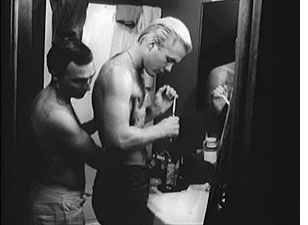 As Joe rubs cream on Paul’s back, and then begins to massage his chest, his almost-successful attempt at seduction is thwarted when first Genevieve, and then Ed, appear to make last ditch efforts to get Paul to themselves. They offer enticements like money, women and travel. Paul, more interested in his reflection in the mirror, ignores them both. And then a third person, a woman who has not been seen in the film before (Dorothy Dean), appears and tells him that he is “very pretty but not exactly literate.” The film abruptly ends as she asks the nasty question, “Why be tied down to these two old faggots?” As Joe rubs cream on Paul’s back, and then begins to massage his chest, his almost-successful attempt at seduction is thwarted when first Genevieve, and then Ed, appear to make last ditch efforts to get Paul to themselves. They offer enticements like money, women and travel. Paul, more interested in his reflection in the mirror, ignores them both. And then a third person, a woman who has not been seen in the film before (Dorothy Dean), appears and tells him that he is “very pretty but not exactly literate.” The film abruptly ends as she asks the nasty question, “Why be tied down to these two old faggots?”
|
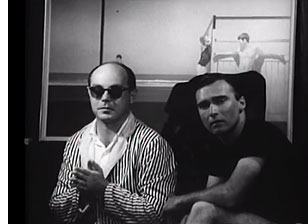 I realize that my account of the film has been spoiler-ridden but I am going under the assumption that most of my readers would rather read about the film than actually have to watch it. I, myself, list the film as one of my guilty pleasures. Even if My Hustler sounds pointless, it does have its moments. Some of the bitchy dialogue between Ed and Genevieve is funny – even if, at times, you can’t believe what you’re hearing. Consider too how long the improvised dialogue is sustained, especially in the second reel. Later, Paul America would claim that he was on LSD that weekend and didn’t realize that they were making a movie. Even though My Hustler is primitively filmed, many images are memorable. Aside from Paul America’s body (undoubtedly the raison d'être for the film), the contrast between the bright beach scenes and the dark bathroom is striking. I also liked the David Hockney-esque painting of swimmers, hanging on the wall behind Ed Hood in the beach house, because it created a composition in depth that mirrored the shots on the beach. And, most of all, I liked that the film is completely unapologetic about its openly queer subject. I realize that my account of the film has been spoiler-ridden but I am going under the assumption that most of my readers would rather read about the film than actually have to watch it. I, myself, list the film as one of my guilty pleasures. Even if My Hustler sounds pointless, it does have its moments. Some of the bitchy dialogue between Ed and Genevieve is funny – even if, at times, you can’t believe what you’re hearing. Consider too how long the improvised dialogue is sustained, especially in the second reel. Later, Paul America would claim that he was on LSD that weekend and didn’t realize that they were making a movie. Even though My Hustler is primitively filmed, many images are memorable. Aside from Paul America’s body (undoubtedly the raison d'être for the film), the contrast between the bright beach scenes and the dark bathroom is striking. I also liked the David Hockney-esque painting of swimmers, hanging on the wall behind Ed Hood in the beach house, because it created a composition in depth that mirrored the shots on the beach. And, most of all, I liked that the film is completely unapologetic about its openly queer subject.
|
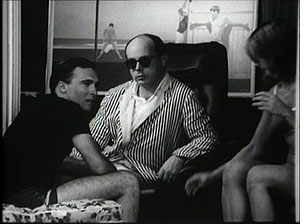 Some interesting trivia: Joe Campbell was once Harvey Milk’s boyfriend. He is also immortalized – as the Sugar Plum Fairy - in Lou Reed’s classic song, “Walk On The Wild Side.” (Reed, of course, was one of the founders of The Velvet Underground. They performed their unique - and ahead of its time - blend of raw rock music at the happenings in Warhol’s Factory.) My Hustler actually enjoyed a short theatrical run in New York City following the minor commercial success of Warhol’s 1965 two-projector epic, The Chelsea Girls. Some interesting trivia: Joe Campbell was once Harvey Milk’s boyfriend. He is also immortalized – as the Sugar Plum Fairy - in Lou Reed’s classic song, “Walk On The Wild Side.” (Reed, of course, was one of the founders of The Velvet Underground. They performed their unique - and ahead of its time - blend of raw rock music at the happenings in Warhol’s Factory.) My Hustler actually enjoyed a short theatrical run in New York City following the minor commercial success of Warhol’s 1965 two-projector epic, The Chelsea Girls.
|
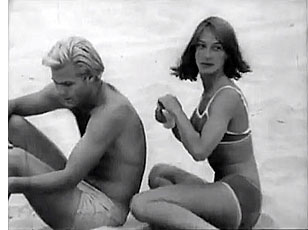 I can remember looking at a MAD Magazine from the 1960s, when I was a kid, which included a spoof of underground movies. The target of one hilarious cartoon was obviously Warhol. It showed a group of people in a warehouse loft standing in front of a camera (and I am sure that one of them was dressed in a bunny suit) and “Warhol” was saying something like: “Okay, we’re going to make a movie that will be 15 hours long so everyone just stand there and do something, anything. Now excuse me, I don’t like to be in the same room while I’m directing one of my movies.” I can remember looking at a MAD Magazine from the 1960s, when I was a kid, which included a spoof of underground movies. The target of one hilarious cartoon was obviously Warhol. It showed a group of people in a warehouse loft standing in front of a camera (and I am sure that one of them was dressed in a bunny suit) and “Warhol” was saying something like: “Okay, we’re going to make a movie that will be 15 hours long so everyone just stand there and do something, anything. Now excuse me, I don’t like to be in the same room while I’m directing one of my movies.”
|
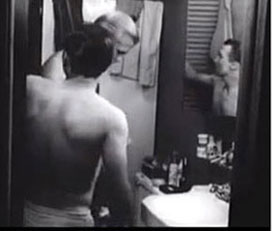 Yes, Warhol preferred whatever was caught on camera to be spontaneous, and it’s typical for his movies to simply end when the film runs out. I can’t take most of his films seriously (has anyone ever really sat through his 8 hour film of the Empire State Building?) but I recognize their historical significance. Warhol was documenting the fringes of society and this was a good thing. He certainly liked to push the envelope; he had already made films about blow jobs, drag queens, nymphomaniacs and S&M sex and, perhaps inspired by the recent publication of John Rechy’s City of Night, felt that the time was ripe to make a film centered around a gay hustler. Unlike most of the era’s sexploitation films, My Hustler actually has a lot going on thematically. For a change, it was a man who was being objectified rather than a woman, and it was deliberately designed to appeal to gay men. My Hustler might not be an accomplished film but, warts and all, it deserves a spot in the history and deveopment of queer cinema. Yes, Warhol preferred whatever was caught on camera to be spontaneous, and it’s typical for his movies to simply end when the film runs out. I can’t take most of his films seriously (has anyone ever really sat through his 8 hour film of the Empire State Building?) but I recognize their historical significance. Warhol was documenting the fringes of society and this was a good thing. He certainly liked to push the envelope; he had already made films about blow jobs, drag queens, nymphomaniacs and S&M sex and, perhaps inspired by the recent publication of John Rechy’s City of Night, felt that the time was ripe to make a film centered around a gay hustler. Unlike most of the era’s sexploitation films, My Hustler actually has a lot going on thematically. For a change, it was a man who was being objectified rather than a woman, and it was deliberately designed to appeal to gay men. My Hustler might not be an accomplished film but, warts and all, it deserves a spot in the history and deveopment of queer cinema.
Other indie and sexploitation films from the 1960s:
Meatrack,
The
Sticks
And Stones
That
Tender Touch
|


